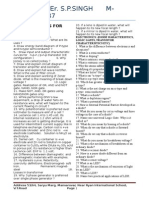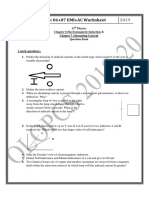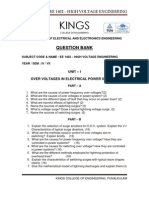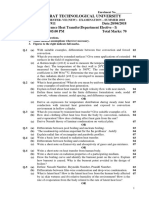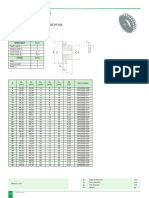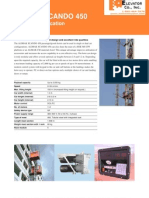0 ratings0% found this document useful (0 votes)
23 viewsASSIGNMENT
ASSIGNMENT
Uploaded by
Elias NegashThe document outlines an individual assignment and group assignment for an Applied Electronics course. The individual assignment contains 10 questions about semiconductor band theory, diode characteristics, and breakdown mechanisms. The group assignment contains 15 questions about diode and transistor biasing, characteristics, and circuit analysis including load lines and stability factors. Students must understand semiconductor physics, diode and transistor operation, and basic circuit analysis to complete the assignments.
Copyright:
© All Rights Reserved
Available Formats
Download as PDF, TXT or read online from Scribd
ASSIGNMENT
ASSIGNMENT
Uploaded by
Elias Negash0 ratings0% found this document useful (0 votes)
23 views3 pagesThe document outlines an individual assignment and group assignment for an Applied Electronics course. The individual assignment contains 10 questions about semiconductor band theory, diode characteristics, and breakdown mechanisms. The group assignment contains 15 questions about diode and transistor biasing, characteristics, and circuit analysis including load lines and stability factors. Students must understand semiconductor physics, diode and transistor operation, and basic circuit analysis to complete the assignments.
Original Description:
For wallaga university
Copyright
© © All Rights Reserved
Available Formats
PDF, TXT or read online from Scribd
Share this document
Did you find this document useful?
Is this content inappropriate?
The document outlines an individual assignment and group assignment for an Applied Electronics course. The individual assignment contains 10 questions about semiconductor band theory, diode characteristics, and breakdown mechanisms. The group assignment contains 15 questions about diode and transistor biasing, characteristics, and circuit analysis including load lines and stability factors. Students must understand semiconductor physics, diode and transistor operation, and basic circuit analysis to complete the assignments.
Copyright:
© All Rights Reserved
Available Formats
Download as PDF, TXT or read online from Scribd
Download as pdf or txt
0 ratings0% found this document useful (0 votes)
23 views3 pagesASSIGNMENT
ASSIGNMENT
Uploaded by
Elias NegashThe document outlines an individual assignment and group assignment for an Applied Electronics course. The individual assignment contains 10 questions about semiconductor band theory, diode characteristics, and breakdown mechanisms. The group assignment contains 15 questions about diode and transistor biasing, characteristics, and circuit analysis including load lines and stability factors. Students must understand semiconductor physics, diode and transistor operation, and basic circuit analysis to complete the assignments.
Copyright:
© All Rights Reserved
Available Formats
Download as PDF, TXT or read online from Scribd
Download as pdf or txt
You are on page 1of 3
WALLAGA UNIVERSITY
COLLEGE OF ENGINEERING AND TECHNOLOGY
DEPARTMENT OF ELECTRICAL AND COMPUTER ENGINEERING
I) APPLIED ELECTRONICS INDIVIDUAL ASSIGNMENT (20%)
1. How does the band gap indicate whether or not your substance is an insulator,
semiconductor or conductor?
2. What is cut-in voltage or knee voltage of a diode?
3. Can a bias voltage or bias current remain constant?
4. What is the purpose of a p-type and n-type semiconductor?
5. What is the purpose of understanding band theory?
6. Why does semiconductor have fewer free electrons than a conductor?
7. Which electrons are responsible for current in a material?
8. By what process are the minority and majority carriers produced?
9. What is the typical value of barrier potential for a germanium diode?
10. When does reverse breakdown occur in a diode?
II) APPLIED ELECTRONICS GROUP ASSIGNMENT (30%)
1. Which bias condition produces majority carrier current?
2. What happens to the barrier potential when the temperature increases?
3. Explain how to generate the forward bias portion of the characteristic curve.
4. Write at least five diode types with their applications
5. What bias conditions must exist for a transistor to operate as an amplifier?
6. What is a load line for Common Emitter circuit?
7. What is reverse saturation current (ICO)?
8. Draw and compare V-I characteristics of typical Ge and Si diodes.
9. calculate the forward resistance of the germanium diode, at IF=60mA10. At IF = 60 mA,
VF = 0.33 V.
10. The voltage across a silicon diode at room temperature of 30ok is 0.71 V when 2.5 mA
current flows through it. if the voltage increases to 0.8V, calculate the new diode current.
11. In a certain transistor the emitter current is 1.02 times as large as the collector current. If
the emitter current is 12 mA, find the base current.
12. For the dynamic characteristic shown in figure below, determine the dynamic resistance at
40 mA.
13. Design a voltge divider bias circuit for the specified conditions. Vcc=12V, VCE=6V,IC=1
mA, S=20, 𝛽=100 and VE=1V
14. Find the load resistance for this circuit in figure below, for IF = 20 mA
a) Draw Load line
b) plot Q-point
c) What is R L from the load line?
15. In the circuit shown in fig below Vcc=24V, Rc=10k and RE=0.27 K. The transistor used
has 𝛽=45. If under quiescent conditions, VCE=5V and VBE= 0.6V, calculate the value of
RB and the value of stability factor s.
You might also like
- Sample QuestionsDocument8 pagesSample QuestionsSong BrokerNo ratings yet
- Kings: Question BankDocument11 pagesKings: Question BankpootommyNo ratings yet
- EE1152Document5 pagesEE1152Saranya PrabhuNo ratings yet
- Electronic Devices and CircuitsDocument12 pagesElectronic Devices and CircuitsAnandhi SrinivasanNo ratings yet
- Basic Electrical and Electronics Engineering (BEEE) (I Year I Sem) Unit - I Short QuestionsDocument4 pagesBasic Electrical and Electronics Engineering (BEEE) (I Year I Sem) Unit - I Short Questionsmonika0404No ratings yet
- Other 22122021211053993Document6 pagesOther 22122021211053993Dhrubajit Acharya Bishal 222-15-6242No ratings yet
- Edec Question Paper-IDocument8 pagesEdec Question Paper-IarunfriendsNo ratings yet
- Ec2151-Electric Circuits and Electron Devices: Question BankDocument8 pagesEc2151-Electric Circuits and Electron Devices: Question BankabvajaNo ratings yet
- Study Guide EE225 Ver1Document6 pagesStudy Guide EE225 Ver1aonNo ratings yet
- Question Bank BeeDocument25 pagesQuestion Bank Beedhruv goraiNo ratings yet
- Anna University Affiliated Colleges Be Eee Semester Vi Ee2353 - High Voltage Engineering Unit - Iover Voltages in Electrical Power SystemsDocument6 pagesAnna University Affiliated Colleges Be Eee Semester Vi Ee2353 - High Voltage Engineering Unit - Iover Voltages in Electrical Power Systemspvanitha143No ratings yet
- High Volteage EngineeringDocument5 pagesHigh Volteage EngineeringSenthil NathanNo ratings yet
- Semiconductor QBDocument9 pagesSemiconductor QBdheeraj rajNo ratings yet
- Physics 12 Imp Questions by Fortune AcademyDocument4 pagesPhysics 12 Imp Questions by Fortune AcademyKamran KhanNo ratings yet
- EC101 Module1Document4 pagesEC101 Module1Ronak SHARMANo ratings yet
- 11o205 Basics of Electrical and Electronics EngineeringDocument4 pages11o205 Basics of Electrical and Electronics EngineeringImranNo ratings yet
- XII Practicals Viva QDocument8 pagesXII Practicals Viva QAnshul Sharma100% (1)
- Question Bank For Module-I: DC, DC, RMS, RMSDocument1 pageQuestion Bank For Module-I: DC, DC, RMS, RMSShubhang CharantimathNo ratings yet
- Beee Upc QPDocument14 pagesBeee Upc QPnarashimagopi123No ratings yet
- Sheet 2. Electric CurrentsDocument3 pagesSheet 2. Electric CurrentsKike Rubio MirallesNo ratings yet
- Experiment No 1-Diode ccDocument6 pagesExperiment No 1-Diode ccMister TomNo ratings yet
- ASSIGNMENT ELE 7208 Advanced High Voltage Enginering: Chapter Per StudentDocument3 pagesASSIGNMENT ELE 7208 Advanced High Voltage Enginering: Chapter Per StudentNuraddeen MagajiNo ratings yet
- Elex 1-5Document14 pagesElex 1-5ssshhhkiNo ratings yet
- Assignment 1 ENT 115 (2013 - SOLUTION)Document16 pagesAssignment 1 ENT 115 (2013 - SOLUTION)Adan A AlawnehNo ratings yet
- SH 1Document9 pagesSH 1moh99eidNo ratings yet
- Is Electric Current A Scalar or Vector QuantityDocument3 pagesIs Electric Current A Scalar or Vector QuantityAshok Pradhan100% (1)
- ECE QuestionsDocument6 pagesECE Questionsbhaskarraj1714No ratings yet
- Beee - Cse - Question BankDocument10 pagesBeee - Cse - Question Bankmrsktrader25No ratings yet
- Electronics Device Circuit Lab SheetDocument27 pagesElectronics Device Circuit Lab Sheetjimfinch512No ratings yet
- Electricity Very ShortDocument2 pagesElectricity Very ShortmeharmelwaniNo ratings yet
- Is Electric Current A Scalar or Vector QuantityDocument3 pagesIs Electric Current A Scalar or Vector QuantityAshok PradhanNo ratings yet
- Physics ImportantquestDocument6 pagesPhysics ImportantquestGummi Sravya Reddy100% (1)
- ElectronicsLab - Manual March2010Document64 pagesElectronicsLab - Manual March2010pnarendrareddy.mscNo ratings yet
- MODULE 1 QBDocument2 pagesMODULE 1 QBBhoomika KcNo ratings yet
- QB KEE101T ElectricalDocument15 pagesQB KEE101T Electricalplantforest16No ratings yet
- 22223.BEE Tutorial Sheet 1 (Semiconductor Diodes and Applications)Document2 pages22223.BEE Tutorial Sheet 1 (Semiconductor Diodes and Applications)Rajiv SatijaNo ratings yet
- E&M Question BankDocument18 pagesE&M Question BankEzhilya VenkatNo ratings yet
- QuestionsDocument2 pagesQuestionsmalladhinagarjunaNo ratings yet
- Assignment-Module 1Document2 pagesAssignment-Module 1الجيش اليمنى الالكترونى YemenNo ratings yet
- Physics Ch6&Ch7 EMI&AcDocument4 pagesPhysics Ch6&Ch7 EMI&AclkNo ratings yet
- Anallysis and Design of Analog Integrated Circuits QuestionsDocument5 pagesAnallysis and Design of Analog Integrated Circuits QuestionsshankarNo ratings yet
- Electrical Engineering B.Tech Question Bank Advanced High Voltage Engineering Paper Code - EE801A Semester - 8Document3 pagesElectrical Engineering B.Tech Question Bank Advanced High Voltage Engineering Paper Code - EE801A Semester - 8joydeep12No ratings yet
- Electrical Circuits Question BankDocument18 pagesElectrical Circuits Question BankRacherla Mega RaniNo ratings yet
- Ee201 - Electric Circuit AnalysisDocument14 pagesEe201 - Electric Circuit AnalysisFLOWERNo ratings yet
- Kings: Ee1003 - High Voltage EngineeringDocument8 pagesKings: Ee1003 - High Voltage EngineeringKumaranNo ratings yet
- Anna University Question Bank - EdcDocument3 pagesAnna University Question Bank - EdcnitmahendranNo ratings yet
- Electrical Circuits & Networks Question BankDocument6 pagesElectrical Circuits & Networks Question BankMATHANKUMAR.S100% (1)
- WWW - Universityquestions.in: Question BankDocument11 pagesWWW - Universityquestions.in: Question BankgokulchandruNo ratings yet
- E-Note 12425 Content Document 20231105014816AMDocument6 pagesE-Note 12425 Content Document 20231105014816AMkartik.doye2005No ratings yet
- EEE AssignmentDocument6 pagesEEE Assignmentaba498242No ratings yet
- EEE(PTEC+Sktec )SuggestionDocument3 pagesEEE(PTEC+Sktec )Suggestionfoysalmehadi131No ratings yet
- 1 W7 Yavy 9 DN EDksrhrpukDocument7 pages1 W7 Yavy 9 DN EDksrhrpukmohinikushwaha736No ratings yet
- MCQ On Basic Concepts of ElectricityDocument10 pagesMCQ On Basic Concepts of ElectricityEirdina ShafwaNo ratings yet
- Answer Key - PTEE6201 - Circuit Theory QPDocument19 pagesAnswer Key - PTEE6201 - Circuit Theory QPSiva KumarNo ratings yet
- PH 2104 Tutorial Set 1Document3 pagesPH 2104 Tutorial Set 1Zuhura RamadhaniNo ratings yet
- Ee 1402 - HveDocument6 pagesEe 1402 - HveckjammyNo ratings yet
- BEE Question Bank With AnswersDocument11 pagesBEE Question Bank With AnswersSyed UmarNo ratings yet
- Electromagnetic Compatibility (EMC) Design and Test Case AnalysisFrom EverandElectromagnetic Compatibility (EMC) Design and Test Case AnalysisNo ratings yet
- PLSQL in 21 Hours - Oracle Interview Based Queries-4Document3 pagesPLSQL in 21 Hours - Oracle Interview Based Queries-4Manohar ReddyNo ratings yet
- Gujarat Technological UniversityDocument2 pagesGujarat Technological UniversityJag Parvesh DahiyaNo ratings yet
- Control and Performance of A Medium-Voltage Cascade H-Bridge STATCOMDocument5 pagesControl and Performance of A Medium-Voltage Cascade H-Bridge STATCOMvinay kumarNo ratings yet
- Bruker Tracerand Artax XRF Raw Spectrum Analysis User Guide Draft PDFDocument54 pagesBruker Tracerand Artax XRF Raw Spectrum Analysis User Guide Draft PDFGuillermo GuerreroNo ratings yet
- Polynomial FunctionsDocument9 pagesPolynomial FunctionsLaurenzhen SorianoNo ratings yet
- Photosynthesis TestDocument4 pagesPhotosynthesis TestLester Eslava OrpillaNo ratings yet
- Download full Image Processing and Computer Vision in iOS Oge Marques ebook all chaptersDocument55 pagesDownload full Image Processing and Computer Vision in iOS Oge Marques ebook all chaptershayekdobie5d100% (4)
- IPcts E Brochure VoipDocument2 pagesIPcts E Brochure VoipOliver NeptunoNo ratings yet
- 01-15-14 Concrete Damaged Plasticity ModelDocument13 pages01-15-14 Concrete Damaged Plasticity ModelatchzytNo ratings yet
- Delta F Nondepleting Oxygen SensorDocument4 pagesDelta F Nondepleting Oxygen SensorAnoss OlierNo ratings yet
- Simple Compound Complex SentencesDocument15 pagesSimple Compound Complex Sentencesapi-261181145No ratings yet
- PVC Tarpaulins Range: Lac 900, Dicoplan, Lac 680, Lac 640, Ecolac 640, UnilacDocument13 pagesPVC Tarpaulins Range: Lac 900, Dicoplan, Lac 680, Lac 640, Ecolac 640, Unilacflorin400No ratings yet
- Goitia HasierDocument236 pagesGoitia Hasierthomas duncan eelesNo ratings yet
- Duplex Chain SprocketDocument10 pagesDuplex Chain SprocketFarrukh RehanNo ratings yet
- Alcatel-Lucent 7750 Service Router - Mobile Gateway: Release 6.0Document4 pagesAlcatel-Lucent 7750 Service Router - Mobile Gateway: Release 6.0George TomaNo ratings yet
- Synopsis DIYA TERM 2Document54 pagesSynopsis DIYA TERM 2AtharvNo ratings yet
- Toolkit: Interface Tool Development SoftwareDocument3 pagesToolkit: Interface Tool Development SoftwareAbdulrehman SoomroNo ratings yet
- 1 s2.0 S0029801820314086 MainDocument18 pages1 s2.0 S0029801820314086 MainMd Rajibul IslamNo ratings yet
- Electrostatic - Separation by SandeepDocument10 pagesElectrostatic - Separation by SandeepSandeep GummallaNo ratings yet
- Barrel CatalogDocument20 pagesBarrel CatalogRafael CardosoNo ratings yet
- Power Quality Guide - US - V01-LowRes PDFDocument44 pagesPower Quality Guide - US - V01-LowRes PDFartsygrl126No ratings yet
- List of Proposed Experiments For Simulation Lab Updated-30th SepDocument4 pagesList of Proposed Experiments For Simulation Lab Updated-30th SepSachi DhanandamNo ratings yet
- Scala Swing DesignDocument17 pagesScala Swing DesignJerome VallonNo ratings yet
- Prokic 'Piezoelectric Converters Modeling and Characterization' UnpwDocument197 pagesProkic 'Piezoelectric Converters Modeling and Characterization' Unpwqudwhvkstj56No ratings yet
- Etab Csi Main Features or CommandsDocument5 pagesEtab Csi Main Features or CommandsKENNYNo ratings yet
- WA - CCS 5000 - GBuujDocument26 pagesWA - CCS 5000 - GBuujDarko TrpkovskiNo ratings yet
- Alimak Scando 450Document1 pageAlimak Scando 450gisele1902No ratings yet
- 6.3 Image Formation by LensesDocument48 pages6.3 Image Formation by Lenseshasnitah81No ratings yet
- Advanced Data StructureDocument3 pagesAdvanced Data Structurearyan kothambiaNo ratings yet
- Thing Equilibrium: Tools and MaterialsDocument4 pagesThing Equilibrium: Tools and MaterialsagestaraswitaNo ratings yet
















